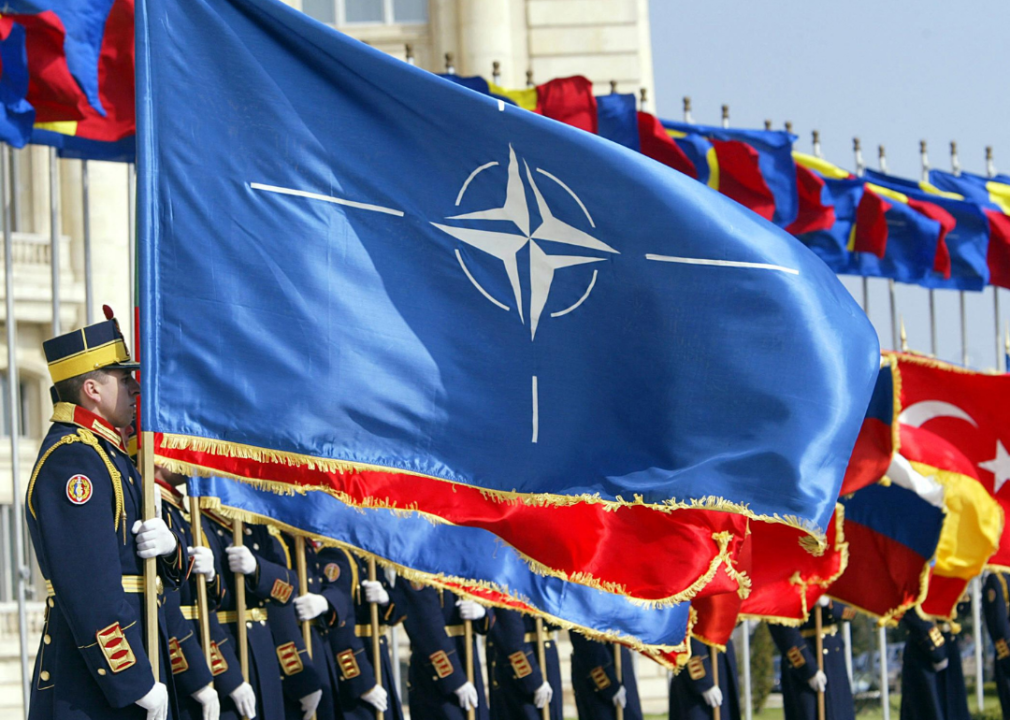How NATO has grown since 1997 and its changing relationship with Russia
Published 10:25 pm Tuesday, June 14, 2022
DANIEL MIHAILESCU/AFP via Getty Images
How NATO has grown since 1997 and its changing relationship with Russia
Since Russia invaded Ukraine in February 2022, Russian President Vladimir Putin has repeatedly cited three decades of North Atlantic Treaty Organization enlargement in Europe’s Eastern bloc as one of several justifications for his unprovoked war. And while neither Russia nor Ukraine is a NATO member, the organization finds itself entangled in the conflict to prevent the escalation of Russian aggression beyond Ukraine’s borders.
NATO was established in 1949, two years into the Cold War, by 10 democratic countries in Western Europe, the United States, and Canada. Its primary objective was to provide collective protection against attacks and influence from the Soviet Union. At the heart of this treaty is Article 5, which holds that an attack on one member country is considered an attack on all, and Article 10, which establishes an open-door policy for any European state that can further the mission and adhere to the founding tenets of NATO.
According to the treaty’s charter, to become a NATO member, countries must have a functioning democratic political system based on a market economy; fair treatment of minority populations; a commitment to resolve conflicts peacefully; an ability and willingness to make military contributions to NATO; and a commitment to democratic civil-military relations and institutions. Even with those criteria met, all existing NATO members must reach a consensus on a country’s application.
In response to the formation of this western alliance and democratization of Europe, particularly West Germany’s admission into NATO in 1955, the Eastern bloc countries created the Warsaw Pact—a communist counterbalance on the continent and an alliance between the USSR, Albania, Poland, Czechoslovakia, Hungary, Bulgaria, Romania, and East Germany.
Unlike NATO’s spirit of agreement and a desire to preserve sovereign democracies, the Warsaw Pact was a treaty meant to protect and serve in the best interest of the Soviet Union. The pact included a provision allowing Soviet military presence and control in member countries—a condition that was exercised in Poland, Hungary, and Czechoslovakia to quash democratic uprisings.
By the mid-1980s, the influence and power of the Soviet Union began to deteriorate. Mikhail Gorbachev, as the new Communist Party Leader of the Soviet Union, proposed more liberal political and economic policies including glasnost (government transparency) and perestroika (economic restructuring) to kick-start a stagnant Soviet economy.
These changes fostered greater autonomy in Soviet satellite countries and increased freedom of political expression. They also drew harsh criticism from staunch Communist party members who viewed these ideological shifts as weaknesses. Instead of igniting an engine of prosperity as he had hoped, Gorbachev’s bungled execution ultimately led to greater economic chaos and the collapse of the Soviet Union.
By 1991, the Warsaw Pact had ended, the Berlin Wall was torn down, and the Soviet Union collapsed. NATO remained in existence even without the threat of the Soviet Union because its mission to deter the rise of militant nationalism and to provide collective security to encourage the democratization of Europe was still relevant. Its existence eventually made way for the democratic pursuits of former Soviet satellite countries, most of whom would seek NATO membership in the coming decades.
From the perspective of Russia’s ruling elite throughout history, the expansion of NATO is a threat to Russia’s security and dominance—every neighboring country with a different ideology, and a NATO-backed military presence, creates the potential for conflict.
The 1997 NATO-Russia Founding Act served as a way to ease these concerns, transitioning from an adversarial relationship to a mutually beneficial alliance with the joint objective of European security. Among the agreement’s most important points are that NATO expansion is not prohibited. Since then, more than 14 countries have been admitted into the alliance, with more seeking membership today.
Russia has largely condemned these admissions, accusing NATO of breaking misconstrued promises not to expand “one inch further east” and enforcing a policy of neo-containment, or ideological isolation. To better understand NATO’s current role on the national stage amid the war in Ukraine, Stacker compiled the history of NATO membership changes since 1997 and how Russia reacted to the events of the era.
You may also like: Countries with the biggest income disparity
![]()

JOHN RUTHROFF/AFP via Getty Images
1999 new members: Hungary, the Czech Republic, and Poland
– Total NATO membership: 19
Poland, Hungary, and the Czech Republic were members of the Visegrad Group, and were among the first formerly Communist countries to pledge a commitment to democratic ideals and a desire to join the European Union. NATO’s admission of these countries in 1999 was the alliance’s first expansion east of Germany—a breach, Russian leaders have since claimed, of a promise made by U.S. Secretary of State James Baker during the reunification of Germany that NATO would not expand one inch to the east.
At the time of their accession, Boris Yeltsin was approaching the end of his eight years in office as Russia’s first President following the dissolution of the Soviet Union. During Yeltsin’s tenure, NATO launched the Partnership for Peace program which allowed non-NATO countries—like former Soviet satellites in Central and Eastern Europe, including Russia—to collaborate with the alliance.
Yeltsin was amenable to the idea of the PfP during its inception in 1993. He viewed it as a replacement for NATO and an opportunity for all of Europe to work together with the goal of collective security—one which did not exclude Russia. However, as declassified documents show, Yeltsin did not understand it was also a path to full NATO membership for participants who chose to meet those criteria. Yeltsin eventually condemned NATO’s enlargement by way of Poland, Hungary, and the Czech Republic, claiming it breached the spirit of promises made not to expand as well as the spirit of inclusion provided by the PfP.

Alex Wong // Getty Images
2004 new members: Bulgaria, Estonia, Latvia, Lithuania, Romania, Slovakia, Slovenia
– Total NATO membership: 26
The admission of the Baltic states—Estonia, Latvia, and Lithuania—brought NATO to Russia’s doorstep. Until that point, no NATO member had shared a land border with Russia. This group also marked the first former Soviet countries to join the alliance. With their accession, they were officially beyond Russia’s sphere of influence, politically speaking.
Under Vladimir Putin’s leadership, Russia initially objected to this enlargement, claiming a NATO military presence in a bordering country was a threat to Russia’s national security. But ultimately, Baltic state membership—even through the eyes of Putin—was a foregone conclusion. The alliance made clear that any lack of formal border treaties—which until then had been considered a non-starter for membership—would in the case of the Baltic states be overlooked, as Russia’s “stalling tactics to impair [their] candidacy” were all too clear to member nations. In 2000, Putin signed the “Foreign Policy Concept” which outlined a commitment to fostering “good-neighborliness and mutual cooperation” specifically with the Baltic states. Russia was more concerned about preserving its improving relationship with the West at this time than blocking their admission.

JOHN THYS/AFP via Getty Images
2009 new members: Albania and Croatia
– Total NATO membership: 28
Russia had no objections to NATO’s admission of Albania and Croatia, though the former’s admission could not have pleased the Russian Parliament given the long-standing differences between the two countries. Albania had been one of the original Warsaw Pact members. As early as 1956, the USSR’s unwillingness to continue championing Stalinist ideology—which had waned significantly following Stalin’s death in 1953—began to erode relations with Albania, specifically its Prime Minister Enver Hoxha, a staunch Stalin supporter. Hoxha openly condemned Soviet leader Nikita Khrushchev for his “Secret Speech,” in which he denounced both the dictatorship of Stalin as well as the cult of personality that had fueled it.
Khrushchev cut aid to Albania in 1960 and 1961, and following the 1961 Warsaw Pact Summit, the USSR’s and other member nations’ embassies in Albania were closed and their ambassadors recalled. Consequently, Albania was de facto expelled from the pact, though it did not formally withdraw until 1968. Hoxha, who held power until his death in 1985, continued to operate what was essentially the only independent Communist nation in the Eastern bloc region.
Following the collapse of the Soviet Union, Albania joined the North Atlantic Cooperation Council (later the Euro-Atlantic Partnership Council) and then the PfP in 1994. Following the war in Kosovo—which ran from February 1998 to June 1999—Albania’s relationship with NATO began in earnest through humanitarian works and the establishment of civil-military cooperation. NATO opened the door to Albania’s acceptance into the alliance in April 2008, and one year later, Albania became a formal member.
Croatia, on the other hand, had established diplomatic relations with the Russian Federation in 1992. Following Croatian independence from the former Yugoslavia in 1991, civil conflict erupted almost immediately between Serbs and Croats, requiring the intervention of the United Nations. The same year Croatia and Russia established relations, the country became involved in the war in Bosnia-Herzegovina. During that conflict, cooperation was established between NATO and Russian forces, a cooperation that would be used as a model during the later war in Kosovo. In 2002, a NATO-Russian Council was established enabling Russia to work in partnership with member nations on “security issues of common interest.”
At the time of Croatia’s admittance to the alliance, this council remained in force, leaving little barrier or threat to Russia from NATO expansion. (This cooperation was suspended in 2014 following Russia’s annexation of Crimea.)

Dursun Aydemir/Anadolu Agency // Getty Images
2017 new members: Montenegro
– Total NATO membership: 29
Montenegro’s acceptance into NATO was met with fierce objection by Russia and split opinion among Montenegrins. Less than 20 years prior, the alliance bombed Montenegro—which was then part of Yugoslavia—during the Kosovo War after evidence was found of ethnic cleansing of Albanians.
While some residents were eager to ally themselves with the West despite the Kosovo bombings, others felt a deep cultural connection to Russia, with whom relations—not mutually beneficial—date back centuries.
Russia made numerous attempts to thwart Montenegro’s NATO membership, including fostering an anti-NATO alliance with the Serbian Church, becoming economically involved by accumulating property in the country and gaining political sway, and openly threatening retribution—calling it a provocation to Russia. Tensions rose further when Montenegro—following suit with the EU—imposed sanctions on Russia for annexing Crimea in 2014. The crescendo came in 2016, when Russian nationalists attempted to assassinate Prime Minister Milo Djukanovic to install a pro-Russian government.
Russia followed through on its promise to retaliate against Montenegro if they joined NATO. Disinformation campaigns, import restrictions, and political blacklists are just some of the retaliatory tactics Russia has employed since 2017.

ROBERT ATANASOVSKI/AFP via Getty Images
2020 new members: North Macedonia
– Total NATO membership: 30
Russia opposed North Macedonia’s desire to join NATO, and in 2018 tried to subvert an agreement between Greece and North Macedonia that would have cleared its path to membership. Eventually, Russia pivoted to open threats and provocations. North Macedonia has been identified as an easy target by and for Russia. The country is viewed by foes and allies alike as NATO’s weakest link due to its small military, vulnerable democracy relative to other member countries, and lack of economic integration into the EU.
Experts postulate that North Macedonia is the NATO bluff Russia is most likely to call. In other words, if Russia attacked, would NATO come to its aid? Persistent Russian meddling in the country and on its borders provides a glimpse of what the alliance must be ready to counteract should its defense mechanism be enacted. Troll farms spreading disinformation and Russian propaganda—such as accusing Albania and the West of attempting to install a pro-Albanian government in Macedonia—have been heavily concentrated in North Macedonia, representing a modern type of attack that NATO only recently addressed in its treaty.
You may also like: US trees are powering Europe’s renewable energy goals—here’s where Americans are most affected

JOHN THYS/AFP via Getty Images
2022 aspiring members: Bosnia-Herzegovina, Finland, Georgia, Sweden, and Ukraine
– Potential NATO membership: 35
Russia’s invasion of Ukraine has sparked interest in NATO membership. A flagrant disregard for sovereign borders has countries with long-standing non-military alignment—such as Sweden and Finland—seeking the military protection and assurances of NATO. While both countries meet all membership criteria, reaching a consensus among current members—specifically Turkey—is causing delays. Turkey’s President Recep Tayyip Erdogan has accused both countries of harboring Kurdish “terrorists” and rejected their applications on those grounds. Kremlin spokesman Dmitry Peskov offered a vague threat that Russia would need to “rebalance the situation” in Europe should these two countries join the alliance.
Russia made similar threats against Bosnia-Herzegovina in March 2022, citing their invasion of Ukraine as what they’re willing to do if the country joins NATO. Igor Kalabukhov, Russia’s ambassador to Bosnia-Herzegovina, stated “we have shown what we expect on the example of Ukraine. If there are threats, we will react,” according to news reports.
Over the last decade and a half, Russia has escalated its resistance to NATO enlargement in Eastern Europe through military offensives and the carving out of pro-Russian territories in developing democracies like Georgia and Ukraine.
In 2008—six months after NATO announced its intention to admit both Georgia and Ukraine as members in the future—Russia invaded Georgia, beginning the five-day Russo-Georgian War. This resulted in the breakaway regions of Russian-backed South Ossetia and Abkhazia.
In 2014, Russia illegally annexed Ukraine’s Crimea region in the Russo-Ukrainian War. With these two events looming over NATO, the alliance opted not to admit either country for fear of Russian escalation in the region.
Historically, NATO membership was not something overwhelmingly supported by Ukrainian government officials or residents. In 2010, Ukrainian President Viktor Yanukovych submitted a law that banned NATO membership for Ukraine, leaving the country—in theory more than practice—neutral.
Today, Ukraine—under President Volodymyr Zelensky—is seeking immediate admission into NATO primarily as a means of securing military support from the alliance in their war against Russia. NATO members including the U.S. are wary of the military commitments attached to the admission of these contested regions.





